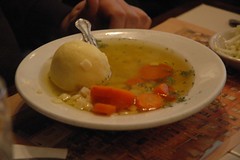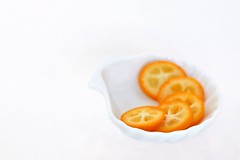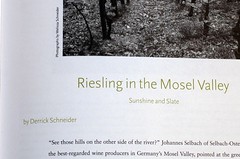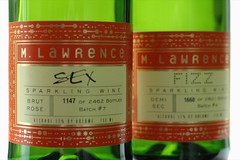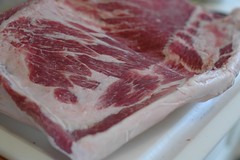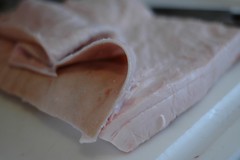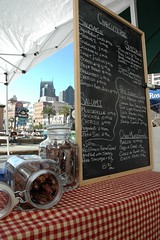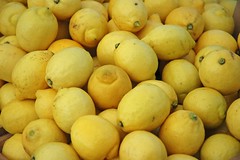Here's a talk I gave at the Wine Writers Symposium about blogs and wine writing. This isn't a transcript but an idealized form of a presentation that's fresh in my mind. I wrote it as I intended to speak it—maybe I should have formatted it as a podcast. It's long, but I've broken it up. Those of you who read Vinography.com have seen Alder's notes from the conference; I'll add my own shortly, as he and I came at it with different agendas
I love the raw, unfettered voice of the author on blogs. I also hate it. Some of you have complained about rambling posts and rampant typos. Plenty of blogs have those problems, but the best offer writing that matches or exceeds most mainstream media. You can't dismiss them outright.
Blogs Are Changing the Landscape
It's clear that blogs change the landscape. Peer-to-peer conversations replace the standard writer-reader relationship. When I write a post, readers leave comments and start a discussion. Another blogger can link to my post, and expand on it at his/her site to start a conversation with that blog's readers. The fact that I have a blog has nothing to do with your ability to start one. It's not like a magazine where you have n slots to fill and too bad for the writers who don't make it in.
This interaction builds a trust relationship that marketers want to exploit. I get email from PR firms all the time who want me to promote their product to my devoted readers.
Magazines And Blogs
Magazines have also noticed the changes. I recently heard a radio interview with Ruth Reichl where she said that Gourmet has changed the way it does things because of blogs. Gourmet no longer does one-off restaurant reviews because the bloggers get there first, and they get there more frequently. At any rate, their reviews, not Gourmet's, come up first in a Google search.
The same is true of wine. If you type in the name of a wine, you're not going to find yourself in the Wine Spectator database, because that requires paid access. But you might find yourself at a review on a blog, which will often tell you something more about the wine. If you get to Alder's site, you'll learn something about the wine makers and the winery. If you get to mine, you'll see some general comments about the region and the style, as well as my thoughts on why I paired it with certain food.
Newspapers and Blogs
Newspapers now incorporate blogs to capture more readers, to run news that didn't fit as a full story, and to build online ad revenue. As many of us know, print ad revenue is down, online revenue is up. Mark Fisher's Uncorked is a good exammple of this form. Mark writes about wine for the Dayton Daily News, and his blog has brought new readers to the site. The online ad revenue is their fastest growing segment, but he's quick to point out that it's still the smallest—it's easy to double when you go from 1 to 2 [Ed. note: These aren't the real numbers].
The most radical example outside of food and wine is in Greensboro, North Carolina, where the News & Record looked at its declining circulation, a common problem among the nation's papers, and decided to reinvent itself. The paper now runs numerous blogs, and the editors, writers, and readers engage in a dialog about articles the public would like to see or follow-ups to stories. The editors don't know if this redesign will solve their problems, but they had to do something or die out.
Personal Blogs
That's why publications might run blogs. On a personal level, a blog provides writing samples to send to editors or a platform from which to pitch a book. Wolfgang [an attendee] got his job at Wine & Spirits in part because of the writing samples on his site. I used a writing sample from OWF to sell my first piece, though looking back on my older posts, I'm surprised it got me the job.
I also think that winery blogs are an untapped gold mine. Imagine giving your customers a sense of ownership by providing a glimpse into how the wine is made. They'd go crazy for it.
Creating a Good Blog
Once you decide to start a blog, some basic techniques will help you attract readers. Number one: write well. A reader has 0 investment in your site. They haven't paid for it, and they're already annoyed by your site's load time when they see it. Grab them right away. Also, realize that people don't read web content—they skim it. Shove all the important words up front, add subtitles to provide anchors, and perhaps highlight keywords, though I don't do this on OWF.
Have a personality. Here's your chance to not write in an established editorial tone. Let yourself shine. Have an "about me" section on your front page so readers know your stance (mine's probably too far down the page).
Have something new or interesting to say. A lot of food and wine blogs write about similar topics. People read them, but if you write in that style, you'll have a hard time rising above the noise. Tom Wark's blog provides a good example in the wine blog world. Tom writes about the business of wine, and how the world of wine PR works. No one else does. His site is probably one of the most widely read wine blogs because of this unique stance. Outside of food and wine, I thought of a site, not even six months old, that rocketed into the Top 100 list maintained by one site [Ed. note: Of course it's not on the list today]. The site is called Cute Overload, and they just post pictures of cute animals all day [Laughter]. Yes, it's ludicrous, but that site has more readers than many of the publications we write for.
Work on your look. When you start your blog, your software comes with a handful of standard designs. You choose your favorite, start blogging, and then realize that four million other people chose that same template, and yours looks like all of the others. I'm the first to admit that OWF doesn't have a great design, but even my changes have had an impact: I interviewed someone recently who said, "Oh, I know your site; it's the one with the copper pots."
Publish on a regular schedule. Readers like the comfort of putting a blog into their routine [Ed. note: News readers would have been off topic and confusing]. Some of the most popular bloggers publish several times a day. Alder publishes almost every day. On the other hand, Regina Schrambling's snarky commentary about the food world at Gastropoda comes out on Monday. It doesn't matter what the schedule is, as long as it's predictable [Ed. note: My readers will note that I don't do this, but I don't pursue readers in an active way]


